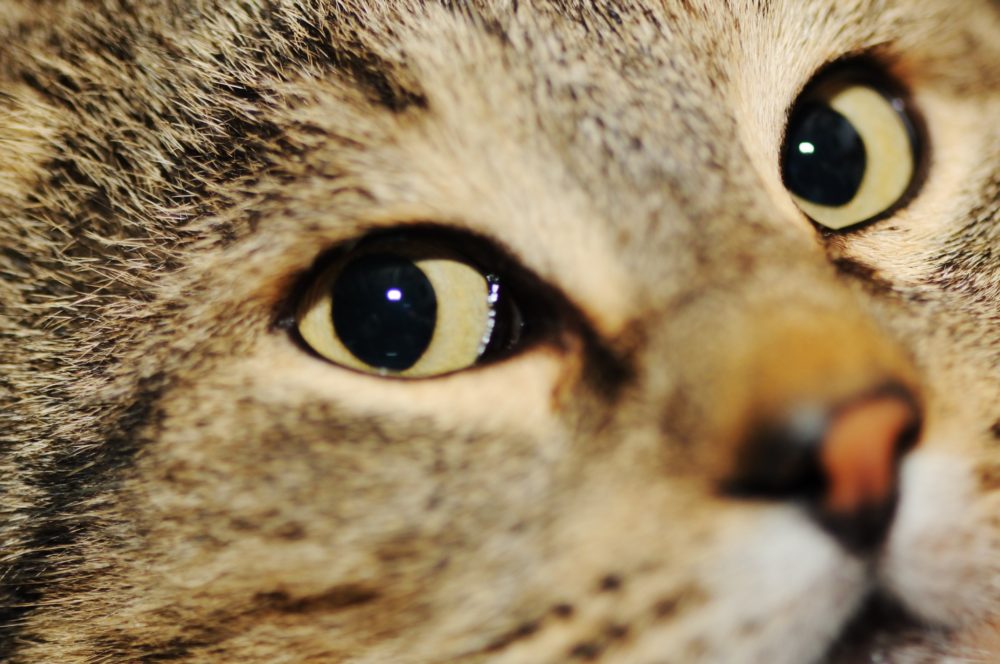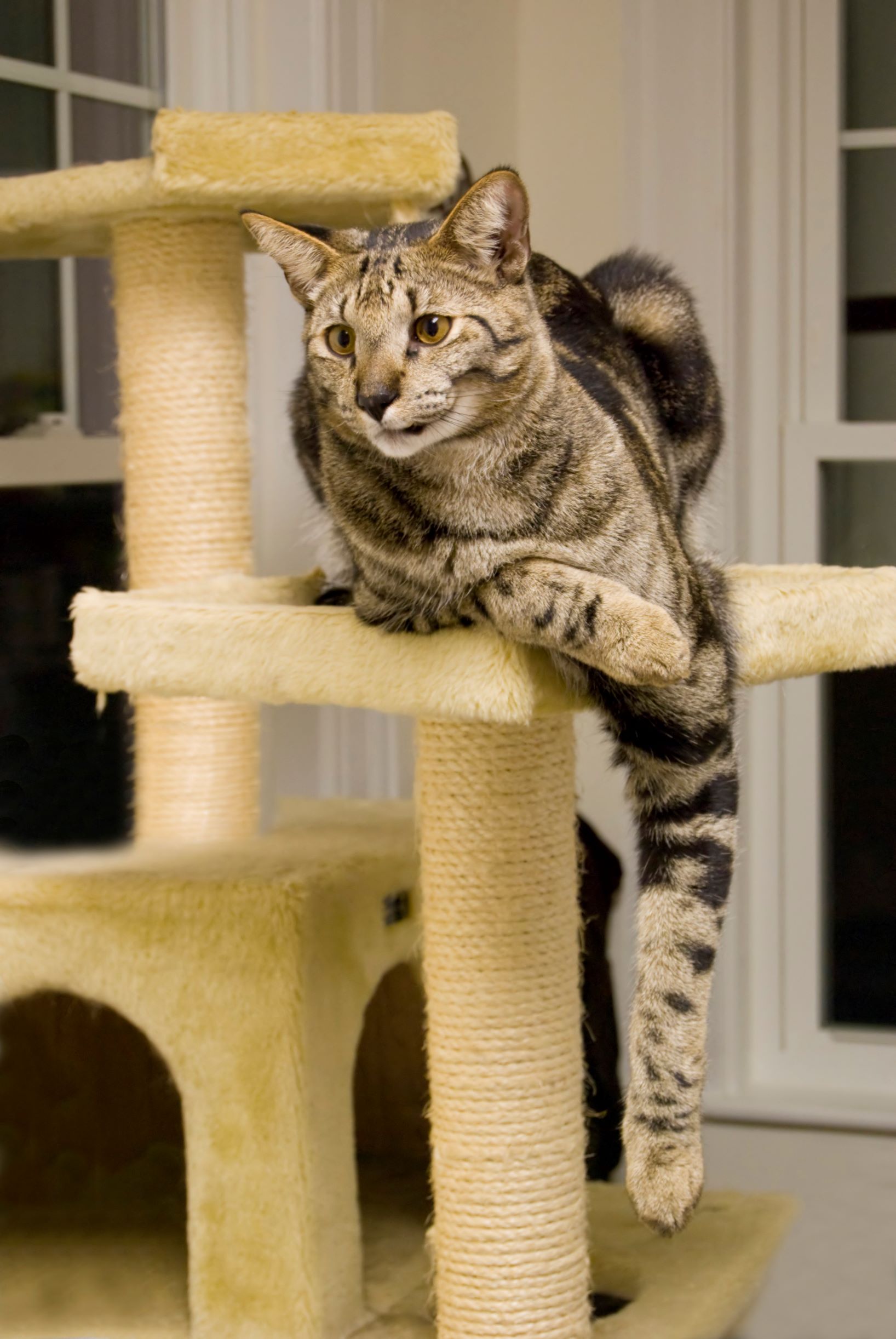
Creating the ultimate cat friendly garden – 10 top tips
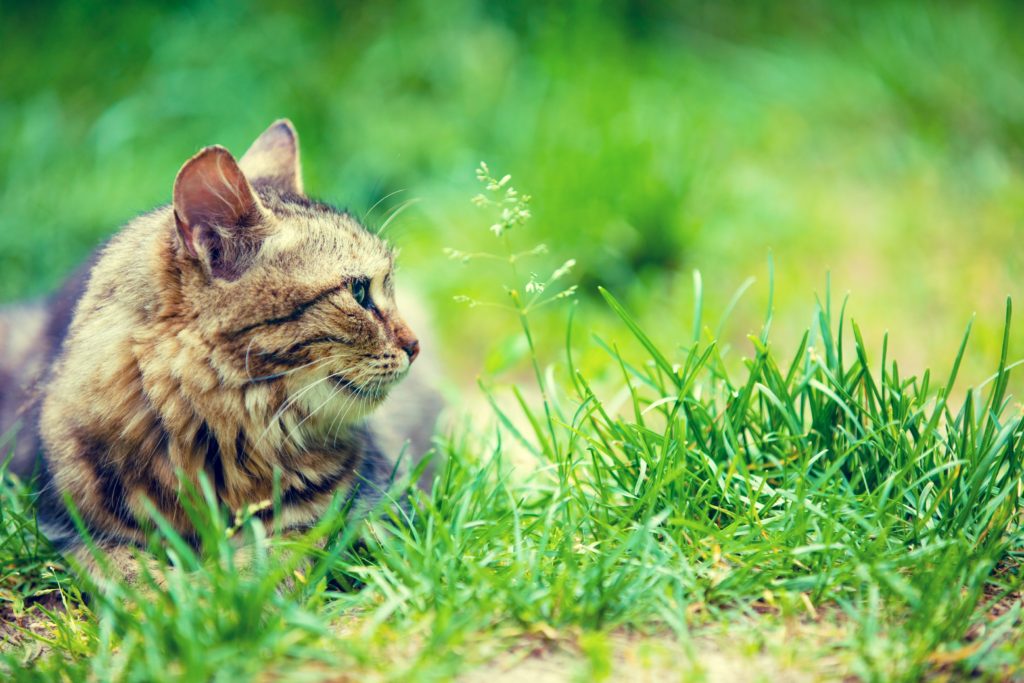 Whether your cat is allowed to roam freely outdoors, or has outside access on a harness, or you are looking to fully secure your garden so your cat can access without wandering away, there are many things that can be done to ensure your garden is a safe haven for your cat. Many of these things are simple, inexpensive and easy changes or additions. They will enhance the garden experience for your cat. By ensuring most of these are included in your garden, there is a greater chance that your cat will be happier within the garden boundary and less likely to wander further afield.
Whether your cat is allowed to roam freely outdoors, or has outside access on a harness, or you are looking to fully secure your garden so your cat can access without wandering away, there are many things that can be done to ensure your garden is a safe haven for your cat. Many of these things are simple, inexpensive and easy changes or additions. They will enhance the garden experience for your cat. By ensuring most of these are included in your garden, there is a greater chance that your cat will be happier within the garden boundary and less likely to wander further afield.
The top ten tips for creating the ultimate cat friendly garden are:
- Provide safe secure fencing
- Allocating a space for a private toileting area
- Provide a scratching area
- An activity area for some playtime fun
- Ensure plants are safe for cats
- A shelter area from cold wet weather or shade from the hot sun in summer
- Access to fresh drinking water
- Places to get up high
- Comfortable areas for those afternoon naps
- A safe haven from harsh toxic chemicals
1. Provide safe secure fencing
Opinions and needs will vary greatly when it comes to outside access for cats and how much freedom to give your cat. And as such there are many options as to the degree of enclosing your garden. For total security there are two options:
- A catio – a secure outdoor enclosure for cats. It doesn’t usually allow full access of the garden but is a safe enclosure that allows your cat healthy exercise time and the enrichment of outdoor stimulation whilst protecting them from outside dangers. A catio can be purchased readymade or designed and built bespoke by a professional or can be built yourself. We have built our very own catio, read all about our catio build here at ‘What is a catio’. This article will also advise on what to put in your catio to make your cat as comfortable as possible.
- Secure border fencing is the second options for total security. There are many providers that sell and install this type of fencing but in essence it is a system of high steel mesh fencing with a fence top barrier that fits around the perimeter of the garden. It is important to identify every potential jump pad such as a window ledge or shed roof and secure even the smallest of corners or spaces where a cat could escape. Many cat owners are now opting for such fencing systems in their gardens, but it must be remembered that the fence must be 100% cat proof to be effective.
The benefits of providing a totally secure area include:
- providing your cat with fresh air, exercise and outdoor adventure in a safe protected area
- safety from outside hazards such as poisons, vehicles, neighbouring cats and dogs
- reduce the costs and stress associated with injuries and diseases
- peace of mind that your cat is safe all the time
- protection for the birds and wildlife in your garden
- creating additional space if you have more than one cat
- ensures your cat stays in their own back yard and doesn’t wander into neighbour’s gardens
- make it an area for you, your cat and the whole family to enjoy together
If a totally secure enclosure is not a priority then creating a dense country style hedge will create more fun and mystery for your cat. Holly, beech and hawthorn are all slow growing, classic hedgerow plants which have the added benefit of encouraging wildlife. this will create a great place for your cat to explore and to hide.
2. Allocating a space for a private toileting area
To ensure the garden works for all members of the family, dedicate a specific area for your cat’s outdoor toileting needs. This will ensure sand pits and flower beds can be what they are designed for rather than used as giant litter trays! The area you designate should be a quiet and private areas of the garden. Provide fresh soil, sand or woodchip and remember to clean up as you would do with a litter tray. Privacy can be provided by planting some evergreens or create a border with some potted shrubs and flowers. Introduce your cat to this area by taking her there often and reward when the area has been used. Cats are very clean animals and prefer to use a toileting area that is away from their food and water. But remember, some cats may simply prefer to use a litter tray. Outdoor litter trays are available. Place the tray somewhere private and accessible.
3. Provide a Scratching area
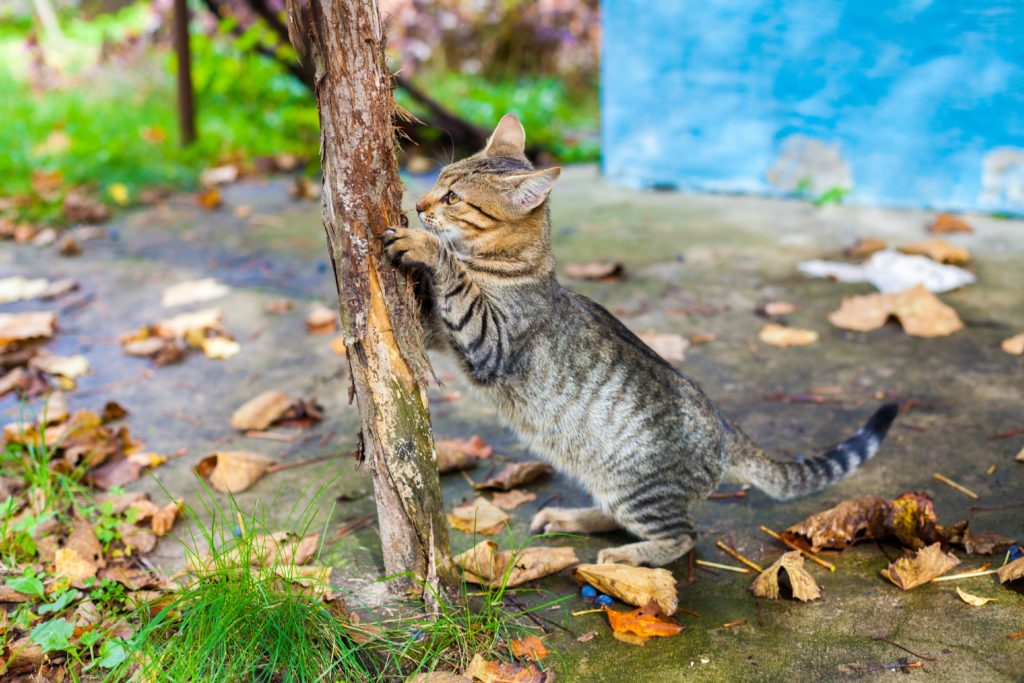 Scratching is a natural and essential behavior in cats. It is done in order to maintain their claws and as a method of marking territory. Some cats prefer a horizontal scratching post, others may prefer vertical posts so why not provide both options to ensure your cat’s scratching needs are satisfied. Trees in the garden are perfect readymade vertical scratching posts. If you are planning to cut down a tree in the garden or already have a tree stump this can be a perfect spot for your cat to scratch. Some wooden boards or cut branches will make great vertical scratching posts for your cat.
Scratching is a natural and essential behavior in cats. It is done in order to maintain their claws and as a method of marking territory. Some cats prefer a horizontal scratching post, others may prefer vertical posts so why not provide both options to ensure your cat’s scratching needs are satisfied. Trees in the garden are perfect readymade vertical scratching posts. If you are planning to cut down a tree in the garden or already have a tree stump this can be a perfect spot for your cat to scratch. Some wooden boards or cut branches will make great vertical scratching posts for your cat.
4. An activity area for some fun playtime
Playtime is just as important for cats as feeding and keeping them warm and safe. Both indoor and outdoor cats need to be provided with a stimulating and safe indoor environment to relieve stress, anxiety and behavioural problems. Spending a little time every day playing games with your cat will boost your relationship and is a great way to get to know and understand each other better. Some cats just don’t like to be picked up or stroked but may more than happy to spend a little time having fun playtime. Other benefits of play time with your cat includes:
- exercise for your cat, keeping bones and muscles strong and healthy
- it can be a great tool for helping two cats to get along and become friends
- build the trust between you and your cat
Once again, you don’t have to spend a lot of money on toys. Get creative and create your own activity centre for your cat. Some ideas include:
- create surfaces with varying textures,
- hang toys from a frame or a bench, when the wind picks up your cat will have a lot of fun trying to catch them,
- provide tunnels to explore which is also great for shade too’
- a section with secured logs of varying heights for your cat to jump from one to another,
- If you are feeling creative, why not make a wooden climbing tower, or there are options to buy readymade. Cats love to climb and be able to view their territory.
- Large plant pots are great places to hide and explore.
If you make a home-made toy, ensure all materials used are safe and nontoxic. Check out our article ’18 Games to play with your cat’ for more ideas and an insight into the importance of playtime with your cat.
5. Ensure plants are safe for cats
Plants will provide cats with many sensory pleasures from their taste, textures and shapes. However, care needs to be taken when choosing plants for your cat friendly garden as some are poisonous to cats if they decide to eat them. Although with a balanced diet and some grass to nibble, it is unlikely your cat will eat harmful plants, prevention is better than cure and they are best avoided. The list of safe and unsafe plants below is by no means exhaustive. If you are in any doubt as to whether a plant is suitable please seek advice from your garden centre or your veterinary.
| Cat friendly plants | Plants to avoid |
|---|---|
| Alyssum Bamboo Basil Begonia Busy lizzie Butterfly bush Catnip Cat thyme Chamomile Coriander Cosmos Dahlia Dill Forget-me-not Hollycock Hyssop Lavender Lettuce Mint Pansy Parsley Rosemary Snapdragon Spider plant Sunflower Thyme Violet | Aloe Vera Amaryllis Autumn Crocus Azalea Bluebell Castor oil plant Christmas rose Clematis Cyclamen Daffodil Easter lily Foxglove Ivy Laburnum Lily-of-the-valley Nightshade Poison ivy Primrose Rhubarb Snowdrop Yew |
Some great ideas for planting which should enrich your cat’s experience in the garden include:
- Tall, oriental grasses such as Miscanthus grass or bamboo will provide great cover for a prowling cat. Any breeze will swish the grasses creating swishing noises and gentle movements.
- A herb garden filled with cat friendly herbs will provide your cat with her very own salad bar! Herbs such as catnip, valerian, cat grass and catmint will cause great excitement for your cat and are sure to be a hit.
- Cat grass is easily available and cats love to chew on this. It is easy to plant and grows quickly. Most cats enjoy chewing on grass as it helps with digestion and helps cats to bring up fur balls.
- If your garden is too small for trees or large shrubs, potted plants can provide great shade for your cat. Look for plants with large leaves.
- Planting certain vegetables can benefits you and your cat! Home grown fresh runner beans are simply the tastiest thing ever and by setting them out to create an arch for your cat to wander through will provide kitty with a shady area too. Trailing varieties of pumpkin and squash can be provide a great area for your cat to hide in and out of.
- Flowers that grow to form a dense cover are great for the hunting instinct in cats. The flowers will attract many insects, bees and butterflies too.
- Fragranced shrubs and flowers will fill the air with a beautiful aroma and your cat will enjoy the fascinating smells too. Scented leaved geranium and lavender are favourites with us.
6. A shelter area shelter from cold wet weather or shade from the hot sun in summer
Shade is needed for your cat all year round. In the summer months shade is needed to keep your cat cool and to ensure they don’t overheat in the warm summer months. In the coldest times of the winter it is likely your cat will head to the safety of the indoors, but shady areas can protect from a sudden rain shower or to take shelter at other times. Plenty of shelter will also make an elderly cat feel more confident about venturing outside. It is important to keep older cats stimulated both physically and mentally too. Your cat may not have quite the same energy levels as her younger days, but they can still enjoy play time. Outside time will help achieve this and ample shelter areas will help in feeling safe and secure.
Large shrubs and trees are great natural shelters. Parasols are ideal in the summer months. Access to a shed or a covered area outside will also provide some shelter from the elements. Old wooden boxes or tables and chairs can help your cat feel safe. A bare or very open garden can make your cat feel vulnerable. Plenty of options for somewhere to hide will make them feel safe and secure. There are several options available to purchase readymade cat shelters or why not build your own little cat house? Here is a little cat house we built out onto an old pallet using offcuts of wood, an old washing machine door and some other bits and pieces we had spare.
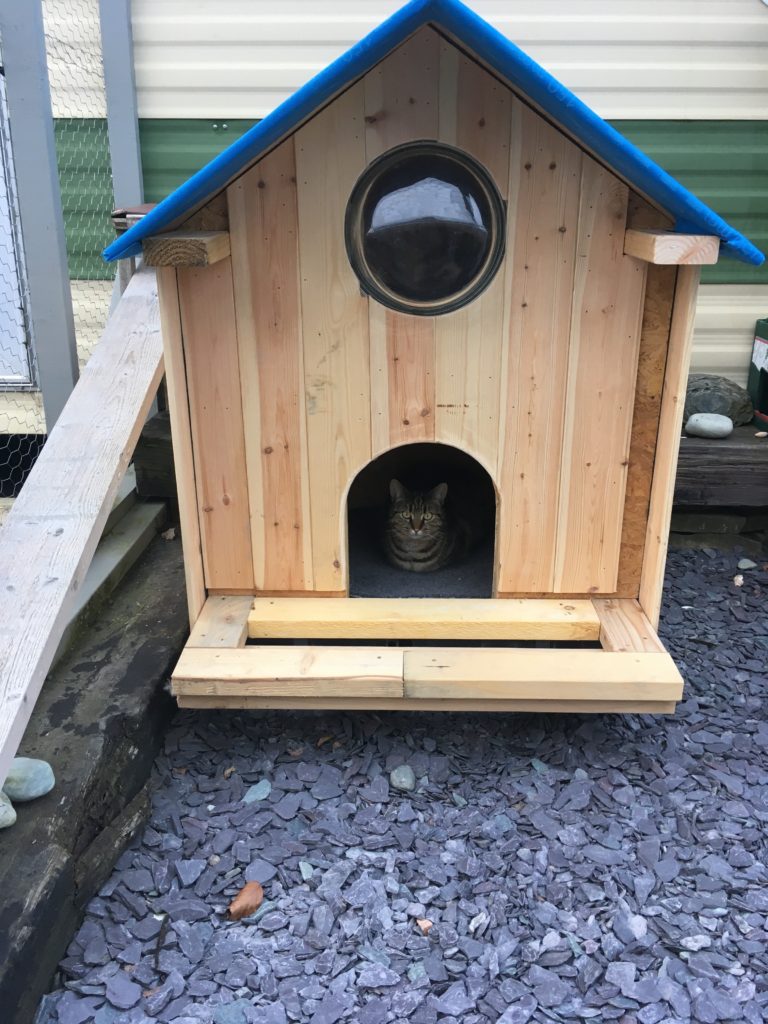
7. Access to fresh drinking water
Every living thing on earth needs water. Just like humans, if cats do not ingest enough water, they may become severely dehydrated therefore water is essential to your cat’s health. Cats can be quite fussy with drinking water – many prefer to drink from a puddle or pond. Many cats dislike the chemical taste of tap water or be sensitive to any taste residue from detergents used to wash their bowls. Therefore, access to fresh rainwater in the garden is perfect. In the absence of puddles, a shallow container to catch the rainwater or even a water fountain will be a great addition to a cat friendly garden. If possible, provide several different sources of water in different locations, your cat can then make her own preferences. Multiple water sources are also useful in a household with more than one cat.
If you do have a pond in your garden your cat will soon realise this is an ideal spot for a little drink. If there are fish in the pond be mindful that there will be the risk of that natural hunting instinct coming into play. Here are some top tips to protecting your pond fish from cats:
- Protect fish by placing a net over the pond. Secure the netting with stones or rocks as cats are very agile and can navigate through the smallest of spaces. Chicken wire is also a great option as netting.
- A large, deep pond is unlikely to be a play area for your cat. Just visiting the pond edge for a little water to quench thirst will be all that is needed from the pond!
- Water sprinklers can be positioned around the pond to be activated by motion. If a cat decides to investigate the pond, the sprinklers will come on – a sure deterrent from trying again!
- A pet proof tough mesh to cover the area of the pond will also protect fish.
- Planting your pond with plants that ensure good coverage, such as water lilies, will provide a good hiding place for the fish. If your cat can’t see the fish, she is unlikely to stick around.
8. Places to get up high
 Cats feel safe in high places. When cats feel threatened, or feel their life is in danger, their instinct is to find somewhere high. Cats will often find higher places more relaxing and will seek these higher spots to chill out. Providing higher up space for your cat to seek a safe place or to sneak there for an afternoon nap is sure to please.
Cats feel safe in high places. When cats feel threatened, or feel their life is in danger, their instinct is to find somewhere high. Cats will often find higher places more relaxing and will seek these higher spots to chill out. Providing higher up space for your cat to seek a safe place or to sneak there for an afternoon nap is sure to please.
Cats love trees – both as scratching posts and as a climbing tool! Cats are excellent climbers; their sharp, extendable claws are perfect for gripping onto the tree while their back legs push forwards. To prevent themselves from falling they hold their bodies, the centre of their weight, close to the tree. They are curious, playful and inquisitive by nature, so it only seems natural to go on an adventure and see what lurks amongst the branches. Be aware that cats will also climb trees to hunt for prey. An outside cat spends a great deal of her time hunting. Even though cats were domesticated nearly 10,000 years ago the natural hunting instinct remain a strong urge in cats. And even if your cat is provided with plenty of food they will still hunt as it keeps them agile and mentally stimulated.
Ensuring there are plenty of other places to hide up high and plenty of other activities may lessen the chance of your cat climbing trees! Access to a shed or an open building can make great shelter. High shelves and some empty boxes will make it a go to place when your cat needs some security or quiet time. There is always the worry with climbing trees that cats may get stuck! If your cat has a particular fondness for tree climbing, have a read of our article ‘Why do cats climb trees’ which contains useful information if they happen to get stuck.
9. Comfortable areas for those afternoon naps
 Cats are most active at dusk and dawn and in between will happily be sleeping for a lot of the time. Being carnivores, feeding on calorie-rich protein means they do not have to be constantly eating. They restore their energy through sleep and will happily sleep for anything between 12 to 20 hours per day. Providing your cat with various option of sleeping areas will keep your cat satisfied. This can include areas in your garden. Some will feel safer sleeping in a higher position, at other times a sunny, warm spot will be just perfect for a little nap. If your cat is a little timid a sleep may be preferred in somewhere secure.
Cats are most active at dusk and dawn and in between will happily be sleeping for a lot of the time. Being carnivores, feeding on calorie-rich protein means they do not have to be constantly eating. They restore their energy through sleep and will happily sleep for anything between 12 to 20 hours per day. Providing your cat with various option of sleeping areas will keep your cat satisfied. This can include areas in your garden. Some will feel safer sleeping in a higher position, at other times a sunny, warm spot will be just perfect for a little nap. If your cat is a little timid a sleep may be preferred in somewhere secure.
Options in the garden can include:
- A warm sunny spot
- Under the shade of a bush or tree
- Somewhere elevated in a shed or outbuilding with a little blanket or box for comfort
- If you are feeling creative and enjoy DIY, why not make a little cat house for the garden. We had great fun making a little house for our cats (see picture above) out of unwanted bits and pieces – upcycling at its best!
- And if DIY simply isn’t for you but you would love a little outside shelter for your cat then the choices of readymade cat shelters are endless, something to suit every budget.
10. A safe haven from harsh toxic chemicals
Many chemicals that are used in the garden can be toxic to cats. Even some organic alternatives can be harmful to cats so please check for cat-friendly options to use. Keep all garden chemicals in a safe place out of the reach of cats, children or any other pets. The following are commonly used garden chemicals but are poisonous to cats:
- slug pellets
- weed killers
- rat and mouse poison
- fertilizers
We associate gardening with warm sunny days in the Spring and Summer, but care is needed during the winter too. One of the biggest risks during the winter period for your cat is antifreeze poisoning. Antifreeze is extremely toxic to cats and can prove fatal if they ingest it. It is something that most of us have in the garage ready for those frosty mornings, but it is essential that it is kept well away from the reach of cats. Antifreeze, also known as ‘ethylene glycol ’, has a tempting sweet smell that some cats seem attracted to, but if cats ingest even a little amount it can kill them. Also ensure that any spills on the driveway are cleaned up, if a cat walks through the spillage they are likely to lick their feet and fur clean.
If you think your cat may have ingested any poisonous substance, contact your veterinary immediately. Prevention is better than cure therefore please keep ALL chemicals safely out of reach of pets and children. For further information on causes and symptoms of poisoning please see our article ‘Has my cat been poisoned? Symptoms-Causes-Treatment’.
Top tip
So that your cat has a choice of whether she wants to enter the catio or garden area or not, install a cat flap. This freedom will allow your cat to come and go as the mood takes her.
Benefits of a cat friendly garden
There are several benefits to making your garden as cat friendly as possible:
- Spending time outside exploring and being active will keep your cat fit and within a healthy weight range.
- Time in the garden will ensure your cat is mentally as well as physically stimulated. It will reduce boredom and in turn reduce stress for your cat. Cats love to climb, explore and play and all this will contribute to a fit, well and happy cat.
- It will allow more space if you have more than one cat. Time alone is equally as important as social time for cats and the extra space will offer more places to go.
- The more attractive and interesting that you can make your own garden the less likely it is that your cat will wander off.
- Spending time withy our cat in the garden be it playing with your cat, gardening or just relaxing in the sun, your cat will learn that this is a safe, happy space to be.
Other articles you may find interesting:
Do cats like rain? Where do cats go when it’s raining?
My cat is chasing bees. Should I be worried?
16 Top tips to ensure the senior years are comfortable for your old cat
How to keep your cat happy – 10 key factors
What is a catio / cat enclosure?
Keeping cats safe in winter – a complete guide
Can you give your cat a popsicle? and how to keep your cats cool in the sun

